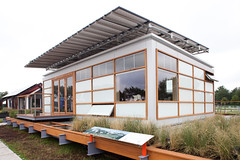In this era of linking transportation and housing to find solutions to energy-related problems, it is heartening that the link was reflected in the wish list of solar/low carbon-emission houses produced for the 2011 Solar Decathlon that just took place in Washington, DC. For any of you not in the know, the Solar Decathlon is a finalist competition of 20 college and university teams from across the country and around the world. The teams are from all types of schools along the collegiate spectrum, this year including an impressive entry from a small liberal arts school (my husband's alma mater) in New England to giant state universities (one of which my sister works for and another 10 minutes from my house). Many of the homes are designed for specific regions and affordability is one component of the competition.
This year, two homes were designed as possible units in multi-family buildings. The City University of New York (CCNY) (my dad's alma mater) entrant was a house that could sit atop an apartment building, surrounded by a rooftop farm or other similar units. I have to admit I used to love spending time on the roof of my building when I was growing up. It is an oasis-in-the-city idea. It also made gorgeous use of light green recycled glass in the kitchen and bathroom. Team Tidewater from Virginia's Old Dominion University and Hampton University, produced a lovely house, the most formally decorated and architecturally detailed in the competition, designed as a unit for a small apartment building in a walkable old small city.
[CCNY house.]
I was happy to see that these schools thought about the energy use of their occupants beyond their front doors to where people travel in their daily lives.
Accessibility: Garden State and Beyond
New Jersey was not far behind in this respect. Its design assumed that homes are usually placed close enough together that privacy is desired and that floor-to-ceiling windows in every room do not provide that. (Disclosure: I had a private tour of the New Jersey house from my cousin, an architecture student, who was on the team.)
Another plus from Team New Jersey that reflected larger societal trends was its complete accessibility, even in the bathroom, for wheelchair users, so that a person in a wheelchair can do more than visit for a few hours, but can actually visit over night or live in the house. Other teams with equal accessibility were Florida International, Maryland, Illinois, Tennessee, and Appalachian State. Indeed, Florida International's design included grab bars throughout the bathroom.
[Bathroom of Appalachian State's house.]
Affordability
We can all have a dream house with enough money, but providing housing that meets societal and personal needs at an affordable price is a challenge. Affordability was well displayed in Team Belgium's entry. The home was made from a house kit the students designed that will enable do-it-yourself building. It is compact, livable and flexible for multiple uses. It also features a design element missing in the 2009 Solar Decathlon, two bedrooms, so that a family could live there.
A few other teams also featured two bedrooms, including Middlebury College (an impressive entrant with a green indoor vegetable wall in the kitchen) and Appalachian State (also beautiful with tin wall in bathroom and outdoor shed storage spaces). Florida International's design also seemed amenable to family use for long-term living.
Something heartening beyond the creativity and commitment of the students was the attention of many teams to universal design, cost concerns, and options (such as solar technology) that are available now. That a few teams actually placed their homes in specific types of walkable - and transit-friendly - locations was a big plus, and one that I hope extends beyond the competition.
[Middlebury's green wall in kitchen.]




No comments:
Post a Comment